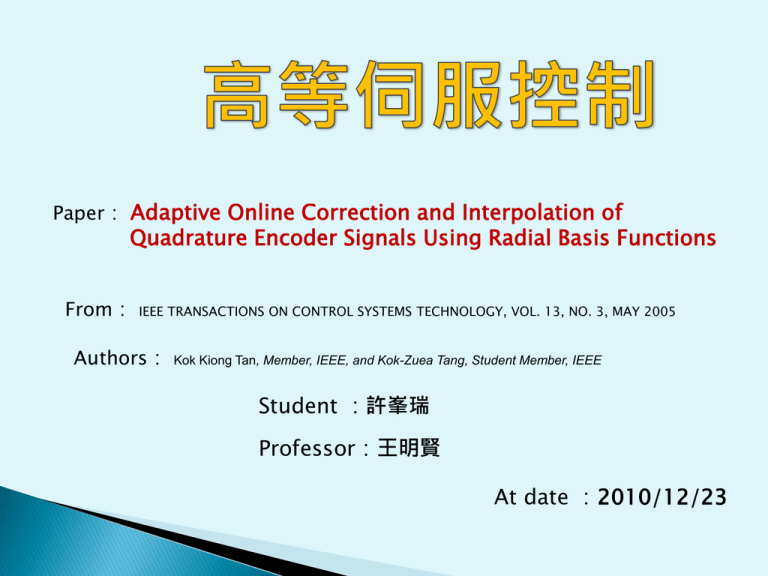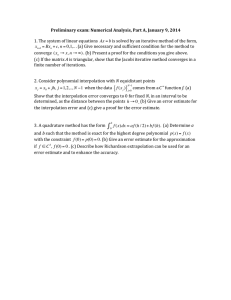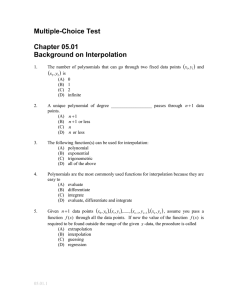Adaptive Online Correction and Interpolation of
advertisement

Paper: Adaptive Online Correction and Interpolation of Quadrature Encoder Signals Using Radial Basis Functions From: IEEE TRANSACTIONS ON CONTROL SYSTEMS TECHNOLOGY, VOL. 13, NO. 3, MAY 2005 Authors: Kok Kiong Tan, Member, IEEE, and Kok-Zuea Tang, Student Member, IEEE Student :許峯瑞 Professor:王明賢 At date :2010/12/23 This paper considers the development of an adaptive online approach for the correction and interpolation of quadrature encoder signals, suitable for application to precision motion control systems. It is based on the use of a two-stage double-layered radial basis function (RBF) neural network. The first RBF stage is used to adaptively correct for the imperfections in the encoder signals such as mean, phase offsets, amplitude deviation and waveform distortion. The second RBF stage serves as the inferencing machine to adaptively map the quadrature encoder signals to higher order sinusoids, thus, enabling intermediate positions to be derived. Experimental and simulation results are provided to verify the effectiveness of the RBF approach. Precision motion control and positioning is a core requirement behind many robotics and drive control applications. To enable it, a precise measurement of the signals generated by the position encoders is essential, since it will determine the final achievable resolution and, hence, accuracy of the motion control application. To increase the precision of the overall system, one approach is to increase the resolution of the encoders. Interpolation using soft techniques provides an interesting possibility to further improve on the encoder resolution, by processing the analog encoder signals online to derive the small intermediate positions. Ideal signals from encoders are a pair of sinusoids with a quadrature phase difference between them. Interpolation operates on the relative difference in the amplitudes and phases of these paired sinusoids. Therefore, interpolation errors will occur if the pair-periodic signals deviate from the ideal waveforms on which the interpolation computations are based. These deviations must be corrected before interpolation. In this paper, the radial basis function (RBF) neural network is employed to carry out concurrently the correction and interpolation of encoder signals. To the best of our knowledge,it is first application of neural network for this purpose. Neural networks ,are inherently useful for approximating nonlinear and complex functions. This is especially true for functions where only the input–output pairs are available and the explicit relationships are unknown. The RBF neural network is one popular and commonly used configuration of neural network which uses a set of basis functions in the hidden units. The effective interpolation of the available sinusoidal signals can be seen as the generalization process for the available data. The square quadrature signals are derived from the sinusoidal signals, after they are corrected and interpolated. The correction and interpolation process can only be performed using the sinusoidal quadrature signals, not the square ones. Thus, the focus of the paper is on the correction and interpolation of the sinusoidal encoder signals. A two-stage RBF network is used in the implementation of the proposed approach. The first RBF stage is concerned mainly with the correction of incoming nonideal encoder signals, including the compensation of mean, phase offsets, amplitude deviations and waveform distortion. This RBF network can be updated adaptively online to reflect any subsequent changes or drift in the characteristics of the encoder signals. The second RBF stage serves to derive highorder sinusoids from the corrected signals from the first stage, based on which a series of high-frequency binary pulses can be converted which, in turn, can be readily decoded by standard servo controllers. Factors affecting the limit and accuracy of interpolation will be discussed in the paper. Consider the RBF network, which is depicted as a two-layered processing structure The hidden layer consists of an array of computing units, i.e., . These hidden units provide a set of functions of the input vectors (i.e., ) as they are expanded into the higher dimension hidden-unit space. The mapping from the input vectors to the outputs of the hidden units is nonlinear, whereas the mapping from the outputs of the hidden units to the final output of the RBF network is linear. The second layer of the RBF network acts as a summer with a set of weights, i.e. The free variables that needs to be tuned are the weights , the centers and the widths . Overall configuration of the two-stage RBF network The precompensation stage : The inputs to the precompensation stage are the quadrature signals direct from the encoders where denotes the instantaneous phase and A denotes the amplitude of the signals. Using a two-layered RBF network, this correction can be easily accomplished as a mapping from raw signals to ideal signals. The Interpolation stage : The inputs to the interpolation stage are from the precompensation stage. The outputs from the interpolation stage are the higher order sinusoids, and , where n refers to the order of interpolation. To reduce the memory requirements of this single-stage RBF network, it is useful to minimize the level of redundancy within the RBF network. In order for the encoder signals to be received by a general purpose incremental encoder interface, the quadrature sinusoidal signals may be converted to a series of binary pulses. Shows the interpolated encoder signals converted to pulses with n = 4096. The pulses are scaled to different applitudes for easy observation. The positioning and tracking performances of the piezoelectric linear motor with a step reference signal and a sinusoidal reference signal It can be observed that with interpolation of encoder signals, the tracking and positioning performances of the controller are greatly improved. Interpolation of the encoder signals increases the precision and accuracy of position measurements of the system. An adaptive online approach for the correction and interpolation of quadrature encoder signals has been developed, suitable for application to precision motion control systems. It is based on the use of a two stage double-layered RBF neural network. The first RBF stage is used to adaptively correct for the imperfections in the encoder signals such as mean, phase offsets,amplitude deviation and waveform distortion. The second RBF stage serves as the inferencing machine to map the quadrature encoder signals to higher order sinusoids. Simulation and experimental results verify the effectiveness of the RBF approach, compared to a lookup table approach.






